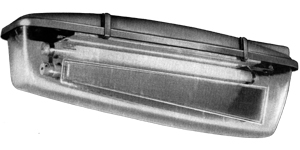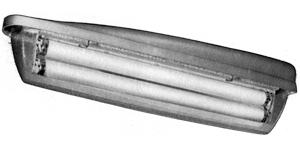 |
GEC Z8256 (Surrey Modification)
Genre: Enclosed Horizontal Traverse Tubular Fluorescent Lantern
After the invention of the tubular fluorescent lamp in 1937 by GE of America, its application to street
lighting was immediately recognised, but all development was delayed by the Second World War. After hostilities
ceased, trial installations using tubular fluorescent lamps were installed in Dublin (using trough
reflectors) and a year later in Rugby and London (using scientifically designed lanterns).
The advantages of fluorescent tubes was immediately apparent. The fluorescent tube was ideally suited for road
lighting, casting a wide beam across the road surface and was relatively unaffected by wet conditions
(which lead to streaks from more compact light sources). It's non-dazzling white light (due to the low
surface brightness of the tube itself) made it an ideal solution for the lighting of high streets, promenades and
civic areas, with smaller units used for residential streets. The only problem was the size of the tubes, which in turn
lead to large lanterns.
The first fluorescent lanterns were huge, bulky affairs, their size dictated by the bulb lengths, the enormous gear
and the limitations of the raw materials of the late 1940s: the lanterns consisted of plate glass panels and metal frames. The optical
system was also complex
treating each lamp as individual source and concentrating its beam in one area using parabolic polished
metal reflectors. Their large size, and equally large capital cost, made lighting authorities hesitant to use
these lanterns.
Fluorescent's popularity increased as new aluminium alloys allowed lighter one-piece canopies to be cast,
which in turn supported new plastic moulded bowls. The optical systems changed again with all the tubes
contributing to the whole: a primary system of lightweight plastic refractors directed the flux onto the road
surface and fashioned the main beams; whilst a secondary system (comprising of white over-reflector)
directed light above the horizontal back to the refractor plates.
Therefore the lanterns became simpler to manufacture and, in turn, their purchase price decreased. They
were still an expensive option, but authorities could justify their use due to their excellent white light (as
compared to the more "artificial" coloured mercury and sodium lanterns). Fluorescent lighting was especially
popular in new town developments and many manufacturers pointed this out in advertisements.
The lantern's large size was still a problem and manufacturers took a tip from European practise and angled
the lantern slightly to disguise its length. Whilst this threw the light further across the road, it was usually
done for cosmetic reasons alone.
The 1950s and 1960s were the age of the fluorescent lantern: it's white light seen as an energy efficient
replacement for ageing tungsten and gas lighting. As gear sizes were gradually decreased, the manufacturers
took advantage by streamlining the lanterns further. Optical systems became simpler until they eventually
consisted of no more than the tubes themselves with a small over reflector.
The energy crisis of the 1970s prompted a rethink. The complex white light fluorescent lantern, usually
burning multiple tubes, was seen as an expensive luxury: a unit burning two 40W bulbs could be replaced by
a single low pressure sodium lantern burning a 35W bulb. The idea that orange light was unsuitable for
residential areas and high streets was swept away by economic necessity. Therefore, as an energy saving measure,
the tubular fluorescent lantern was gradually removed, to the extent that hardly any exist on
public streets anymore.
The use of the tubular fluorescent lamp for street lighting was over. (Although the future looks bright for the
compact fluorescent lamp but that's another story...)

Name: GEC Z8256 (Surrey Modification)
Date: Circa 1960s
Dimensions: Length: 31¼", Width: 9½", Height: 7"
Light Distibution: Non Cut-Off (BSCP 1004:1952)
Lamp: 2 x 40W MCFE/U
History

GEC Z8256

GEC Z8260
|
This lantern started off life as the GEC Z8256 but was modified in service.
It was installed in Surrey. The lighting department at the County Council decided that the replacement bowls were too expensive,
so the council produced their own, slim-line replacement. This required the cutting of the lamp support brackets and repositioning
of the terry clips on the remaining stubs.
Many thanks to Richard Atkinson for the information.
|
Popularity
An extremely rare lantern and only produced by Surrey County Council after modifying in-service GEC Z8256s.
Identification
The lantern has GEC Made In England cast into the canopy. It's possible it originally had an identification sticker
inside the canopy but this has long gone.
Optical System
The light output from this lantern is effectively uncontrolled. The designers were able to do this because of
the characteristics of the fluorescent tube e.g. these lamps already cast a wide beam towards the road surface
(so no spread in azimuth is required) and their low brightness doesnít require any diffraction of the light to
reduce glare.
The only optical control is a white over reflector. This was originally the secondary optical system of the
GEC Z8256 and here it provides the same function, namely simply reflecting flux emitted above the horizontal
back down towards the ground.
The bowl has limited optical features and its primary function is to simply protect the tubes and keep the
interior of the lantern clean.
Gear
The lantern is fitted with the same gear as the GEC Z8256: a choke, power correction capacitor and quickstart fluorescent
starter unit. Smaller capacitors are connected across the quickstart unit to suppress radio interference.
The bi-pin fluorescent connectors are not earthed, suggesting these lanterns used MCFE/U lamps.
|

|
|
facing profile
This lantern was aquired from fellow collector P.. Little is known about its service history other
than it originally stood somewhere in Epsom, Surrey.
|
|

|
|
front profile
After just under 40 years of service (the capacitor is dated 1967), the lantern was in excellent condition. Despite some
rusting of the over reflector and the yellowing of the polycarbonate bowl, it just required a general strip down and clean.
|
|

|
|
trailing profile
At some point, the lantern was fitted with a two-part photo cell. This was removed during the restoration, the hole filled and
the canopy repainted.
|
|

|
|
canopy
Two pairs of toggle clips held the bowl in place. These obviously relied on a thick gasket between the bowl and canopy as without it the
clips felt loose.
|
|

|
|
logo
Like many GEC lanterns, the lantern has the makers name cast into the canopy of the lantern. They often included an
identification sticker inside the lantern as well, but if one was ever fitted, it has long since disappeared.
|
|

|
|
pedestrian view
By later standards, this lantern was large and unwieldy, and probably compared badly with the more streamline lanterns
being produced by other manufacturers (such as the REVO Junior Sol-e-Tern and the
Atlas Beta 6). This probably prompted its redesign.
|
|

|
|
vertical
This vertical view clearly shows how the secondary optical system, the white over reflector, was designed to match the length
of the fluorescent tubes.
|
|

|
|
open bowl
Despite its age, the interior of the lantern has a clean, functional appearance. The use of bi-pin connectors for the tubes leads
to an untidy appearance with stray connecting wires, but this was always a problem with fluorescent lanterns.
The gear was also reasonably accessible, just requiring the loosening of two screws.
|
GEC Z825?: During Restoration
Despite providing just under forty years of service, the lantern was in remarkably good condition. It was
stripped down and given a good clean and the rusty over reflector was stripped and repainted. Unfortunately
the bowl's started to turn yellow (caused by the polycarbonate plastic being exposed to ultraviolet light) but
thereís nothing I can do about that.
The following pictures were taken as the lantern was reassembled.
|

|
|
gear and gear tray
The gear was mounted on the underside of a white enamelled gear tray which was screwed into the canopy
of the lantern.
The components (from left to right) are: a GEC F8570 power correction capacitor, a GEC fluorescent choke
(with missing label) and a GEC F8023 fluorescent quickstart unit. This gear appears to be contemporary
with the lantern, and the date on the capacitor is 1967.
Two capacitors are connected across the quickstart unit; itís assumed these are used for radio interference
suppression.
The bi-pin connectors are not original and a designed for modern, thinner fluorescent tubes. These were removed
during the restoration.
|
|

|
|
gear tray and bulb holders
The tube holders are mounted on the otherside of the gear tray. These hold the two fluorescent tubes parallel with each other
(and not angled like the holders on the GEC Z8256).
|
|

|
|
canopy
The cleaned canopy is remarkably smooth and free of lugs and bosses. The gear tray screws into the two screwholes either end of the lantern
with the gear mounted in the roof of the canopy.
The round hole to the right of the bracket entry slot was drilled for a two-part photocell. This was removed during the restoration, filled and
the exterior painted.
|
|

|
|
canopy components
The GEC kindly provided an earthing screw, porcelean cable cleat and porcelean terminal block as standard. Interestingly
the terminal block in this lantern is also fitted with a fuse - the first time I've ever seen this type of component. It suggests the
lantern wasn't protected by a fuse elsewhere e.g. in the base of a column.
|
|

|
|
canopy and gear tray
The gear tray has now been fitted back inside the lantern and the live and neutral wired to the terminal block.
|
|

|
|
complete reassembly
And after connecting the external wiring and fitting the repainted over reflector, the restoration of this lantern was now
complete.
|
GEC Z825?: During Restoration: As Aquired
This lantern was originally obtained by fellow collector P.. It originally stood somewhere in the Epsom, Surrey area
until 2005 when it was removed and saved.

|



